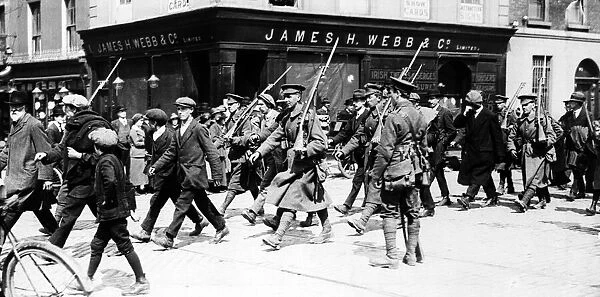Home > Mirror > 0000to0099 > 00007
Rebel prisoners being marched out of Dublin by British Soldiers May 1916 The
![]()
Wall Art and Photo Gifts from Memory Lane
Rebel prisoners being marched out of Dublin by British Soldiers May 1916 The
Rebel prisoners being marched out of Dublin by British Soldiers May 1916
The Easter Rebellion, was an armed uprising of Irish nationalists against the rule of Great Britain in Ireland. The uprising occurred on Easter Monday, April 24, 1916, and centred mainly in Dublin. The chief objectives were the attainment of political freedom and the establishment of an Irish republic. Centuries of discontent, marked by numerous rebellions, preceded the uprising. The new crisis began to develop in September 1914, following the outbreak of World War I, when the British government suspended the recently enacted Home Rule Bill, which guaranteed a measure of political autonomy to Ireland. Suspension of the bill stimulated the growth of the Citizen Army, an illegal force of Dublin citizens organised by the labour leader Jim Larkin (died 1948) and the socialist James Connolly (1870-1916); of the Irish Volunteers, a national defence body; and of the extremist Sinn Fśin. The uprising was planned by leaders of these organisations, among whom were the British consular agent Sir Roger David Casement, the educator Padhraic Pearse (1879-1916), and the poet Thomas MacDonagh (1878-1916).
Hostilities began about noon on April 24, when about 2000 men led by Pearse seized control of the Dublin post office and other strategic points within the city. Shortly after these initial successes, the leaders of the rebellion proclaimed the Independence of Ireland and announced the establishment of a provisional government of the Irish Republic. Additional positions were occupied by the rebels during the night, and by the morning of April 25 they controlled a considerable part of Dublin. The counteroffensive by British forces began on Tuesday with the arrival of reinforcements. Martial law was proclaimed throughout Ireland. Bitter street fighting developed in Dublin, during which the strengthened British forces steadily dislodged the Irish from their positions. By the morning of April 29, the post office building, site of the rebel headquarters, was under violent attack. Recognising the futility of further resistance, Pearse surrendered unconditionally in the afternoon of April 29.
War Conflict Irish Rebellion Easter Uprising
Rebels
British Soldiers Rifle Bayonet
April 1916
1910s
© Mirrorpix
Daily Mirror
Mirrorpix
Ireland
WA*452342
Media ID 21248049
© Mirrorpix
1916 Conflict And Peace Landscape World War 1 World War One
MADE IN THE UK
Safe Shipping with 30 Day Money Back Guarantee
FREE PERSONALISATION*
We are proud to offer a range of customisation features including Personalised Captions, Color Filters and Picture Zoom Tools
FREE COLORIZATION SERVICE
You can choose advanced AI Colorization for this picture at no extra charge!
SECURE PAYMENTS
We happily accept a wide range of payment options so you can pay for the things you need in the way that is most convenient for you
* Options may vary by product and licensing agreement. Zoomed Pictures can be adjusted in the Basket.

